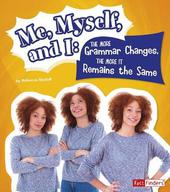
|
Me, Myself, and I--the More Grammar Changes, the More it Remains the Same (Why Do We Say That?)
Paperback / softback
Main Details
| Title |
Me, Myself, and I--the More Grammar Changes, the More it Remains the Same (Why Do We Say That?)
|
| Authors and Contributors |
By (author) Rebecca Stefoff
|
| Physical Properties |
| Format:Paperback / softback | | Pages:32 |
|
| ISBN/Barcode |
9781515763925
|
| Classifications | Dewey:428.2 |
|---|
| Audience | |
|---|
| Illustrations |
Illustrations, color
|
|
Publishing Details |
| Publisher |
Capstone Press
|
| Imprint |
Capstone Press
|
| Publication Date |
1 August 2017 |
| Publication Country |
United States
|
Description
Explains how and why grammar has evolved through the years, and where it is likely to go. Writing prompts engage and challenge the young reader. Meets Common Core standards for Literature.
Author Biography
Rebecca Stefoff has published many books for young readers about science, technology, and engineering. For Marshall Cavendish/Benchmark's Great Inventions series (2006-2003), she wrote six titles, including The Telephone, Microscopes and Telescopes, and Robots. She introduced fifth-grade readers to the scientific method in the six-volume series Is It Science? (Cavendish Square, 2014), which includes, Astrology and Astronomy, Alchemy and Chemistry, and Magic and Medicine. Her six volume series Great Engineering, for second- and third-grade readers, is forthcoming from Cavendish Square and has books on building bridges, dams, skyscrapers, and more. Stefoffis especially happy to be writing about the building of the Panama Canal for the Engineering Wonders series because she has seen the canal firsthand. While celebrating her parents' fiftieth wedding anniversary on a cruise ship, she passed through the canal and witnessed the extraordinary engineering marvels that are its locks. She has been interested in the Panama Canal (and other canals) ever since.
ReviewsBeginning with a general overview of its topic, each text delves into the history and currently active changes of American English. They also go into some finer points, such as the use of emojis as idioms and the evolution of thee/thou to you. Try it out! sections encourage active engagement with functions of language. Subjects: Language; General language; English language; Language--Idioms; Language--Grammar-- "Horn Book"
|